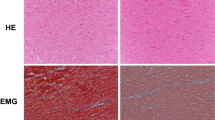Abstract
This study was designed to assess the parameters of myocardial oxidative stress and related cardiac morphological changes following intraperitoneal cocaine exposure in rats. The cardiac levels of reduced glutathione(GSH), oxidised glutathione(GSSG), ascorbic acid (AA), and the production of malondialdehyde (MDA) were measured, as well as the variations of activity in the enzyme systems involved in cell antioxidant defence, glutathione peroxidase (GSH-Px), glutathione reductase (GR) and superoxide dismutase (SOD). After chronic cocaine administration for 30 days GSH was significantly depleted in the heart from 30 min (P < 0.001) to 24 h (P < 0.001) after exposure, and GSSG was increased for a similar time (P < 0.05 at 30 min and P < 0.01 at 24 h). SOD increased during the first hour (P < 0.001), GR and GSH-Px both increased from 30 min to 24 h, and these increases were statistically significant (P < 0.01 and P < 0.001 at 30 min and P < 0.01 and P < 0.001 at 24 h, respectively). The AA levels increased after 1 h (P < 0.01), remaining significantly so for 24 h (P < 0.001) and MDA increased from 30 min to 24 h, all values being highly significant (P < 0.001). The body weight was significantly (P < 0.001) reduced in both cocaine groups (40 mg/kg × 30 days and 40 mg/kg × 10 days + 60 mg/kg × 20 days). The heart weight (P < 0.01) and its percentage of the body weight (P < 0.001) were significantly higher in these two groups than in the controls. Similarly, in the noradrenaline 4 mg/ kg × 30 days group, the body weight was significantly (P < 0.001) reduced and the heart weight (P < 0.01) and its percentage of body weight (P < 0.001) were significantly higher than in the controls. In comparing the cocaine and noradrenaline experiments, the frequency and extent of cardiac lesions obtained with 40 mg/kg × 10 days + 60 mg/kg × 20 days of cocaine were similar to those with 8 mg/kg of noradrenaline at 24 h. In this experimental model, cocaine administration compromised the antioxidant defence system of the heart associated with a significant increase of heart weight and the percentage of body weight.
Similar content being viewed by others
Author information
Authors and Affiliations
Additional information
Received: 11 July 2000 / Accepted: 19 October 2000
Rights and permissions
About this article
Cite this article
Fineschi, V., Baroldi, G., Centini, F. et al. Markers of cardiac oxidative stress and altered morphology after intraperitoneal cocaine injection in a rat model. Int J Leg Med 114, 323–330 (2001). https://doi.org/10.1007/s004140000194
Issue Date:
DOI: https://doi.org/10.1007/s004140000194




